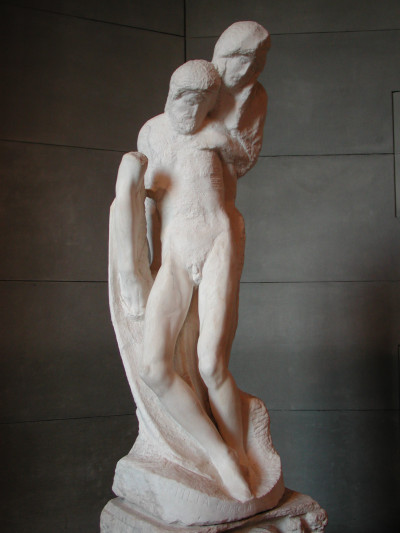Introduction
We can track the provenance of this piece from the early 19th century, but prior to that its existence is less clear. We do know that Michelangelo worked on the piece in several different phases, and eventually dedicated it to his servant, Antonio. The sculptor was well versed in the Pieta theme, having already made use of it in a number of other sculptures, and this particular work combined elements of those previous iterations.
Whilst the attribution to Michelangelo has been firmly accepted by scholars for centuries, there remains a number of questionmarks around its inception. Some have suggested that other versions of the Rondanini Pietà were produced, and there is also controversy around whether Michelangelo considered the piece completed or not. Most drawings connected to its preparation have been rejected as the work of Michelangelo, further clouding our understanding of his work within the 1550s.
This sculpture is highly significant because of it being Michelangelo's last. The sculptor was known to be dwelling on his own mortality more and more in the years leading up to his death, and some of his artistic style changed as a result. Additionally, he was taking on uncommissioned projects, with the intention of potentially including some of these late works within his own tomb. Having planned and executed a number of tombs for others, he would be forced to plan his own after life from the early 1550s onwards.
Table of Contents
- Introduction
- Why is it called the Rondanini Pietà?
- Description
- Meaning
- Style
- How many versions of the Rondanini Pietà were there?
- Timeline
- How Long did Michelangelo work on the Rondanini Pietà?
- Did Michelangelo Finish the Rondanini Pietà?
- Location and Provenance
- Size and Medium
Why is it called the Rondanini Pietà?
This Michelangelo sculpture became known as the Rondanini Pietà because, for many years, it was displayed at the Palazzo Rondanini in Rome, Italy. The sculptor himself produced a number of Pietà depictions, and a common way in which similar Renaissance paintings and sculptures were differentiated and identified was by naming them either after their owner, or their location. Additionally, if there was more than one version of this sculpture design, which many scholars believe to be the case, then including the locations within their respective names is the best method to telling them apart.
Description
What is the Pietà?
The Pietà is an artistic genre in which the Virgin Mary holds the dead body of her son, Jesus Christ, in her arms, or lap. The content is very similar to the descent from the cross, but occurs after Christ has been taken down from the cross, and only ever features these two figures.
Composition
This depiction of Pietà features the Virgin Mary stood behind Christ. They are both stood upright, but Jesus is being held up by his mother's embrace. The postures of the two figures is unusual for this theme, when normally Christ would be lying down, with a much more obvious image of his fate and vulnerability. Indeed, Michelangelo followed that format elsewhere in his oeuvre but is perhaps attempting to be more innovative with the Rondanini Pietà, with it being his last sculptured piece.
If we look closely at the piece, we notice that both figures have relatively under developed facial expressions. Prominent noses dominate, with small sections carved for the eyes and mouth. Their hair is also left as a vague, rough surface. It feels more dreamy than real, with Michelangelo providing a suggestion, or impression, of form, rather than craving out every last detail, just as the French Impressionists would do with oil many centuries later.
Christ's lower half, it must be pointed out, is much smoother in its finish. His long, slim legs stretch out right to the base and appear anatomically over-sized. As a result, they also attract one's attention first. Michelangelo's male sculptures are best known for their toned physiques, but here we see little of that detail - he sometimes depicted Christ as skinny and underfed within his Pieta depctions, but there are no signs of his rib cage either - his torso is devoid of any real detail.
Meaning
The term Pietà means pity, or compassion. Within art, it therefore refers to the emotions of the Virgin Mary as she mourns the loss of her son, Jesus Christ, whilst holding him in her arms. Michelangelo's version here continues that same theme, but in an alternative style, with simpler, less detailed features and also limbs which are extended beyond what might expect to see in reality.
Style
The Rondanini Pietà displays Michelangelo's evolution as an artist, capturing his final flurry of creativity prior to his death in 1564. Whilst some may conclude that the piece was simply unfinished, with rough detail failing to match the precision of earlier sculptures, this was entirely deliberate. Michelangelo now wanted to produce idealised versions, creating a mystical atmosphere around his works, rather than looking to reproduce reality in stone.
In some ways, one might argue that this was a return to the approach taken within the Gothic period, though others have drawn connections to the later Mannerist movement, in which a greater emotion is instilled in the piece and the elongation of limbs would become entirely expected. El Greco's work was a good example of that, with Michelangelo's sculpture here giving Christ particularly long legs, when compared to the dimensions of his torso.
Michelangelo was a master of the human anatomy, and would not have been working in an inaccurate manner by accident or error. He simply desired a new style for his portraits, perhaps inspired by the feeling that he had already mastered the precise approach in previous decades and required a new challenge for his work.
How many versions of the Rondanini Pietà were there?
A number of scholars from the 19th and 20th century have suggested that there may have been three different versions of the Rondanini Pietà, with this being the last of them. This theory is unlikely to ever be proven, and most preparatory drawings linked to this project have also had their own attributions questioned, leaving many questionmarks about Michelangelo's work in that period.
Timeline
The timeline of Michelangelo's late period, below, illustrates some of the other sculptures which appeared just before this final piece. The artist's productivity dropped in his final years, and as passionate as he remained as an artist, Michelangelo's body started to let him down across the final decade. His behaviour also became erratic, perhaps due to the frustration of being unable to work in the same manner as his younger years. He dramatically attacked some of his sculptures in fits of rage, and never lost his ambitious nature that drove much of his earlier success.
- 1530–1534 - Crouching Boy
- 1519–1520 - Christ Carrying the Cross
- 1538 - Brutus
- 1547–1553 - Florentine Pietà
- 1552/1553–1564 - Rondanini Pietà
How Long did Michelangelo work on the Rondanini Pietà?
Michelangelo worked on the Rondanini Pietà from around 1552/1553 to within six days of his death in 1564. It is believed that the sculptor re-visited the piece on several occasions and that the majority of his work was completed in two or three main phases of work. A number of theories have been put forward around how Michelangelo spent this long period of time, with some providing drawings as proof of his preparatory work, whilst others have suggested that he actually completed several different versions of the piece during that decade, with this being the final one.
This extended length of time may also have been impacted by the failing physical health of the artist, who became less and less able to carry out the physical tasks of sculpting. His persistence and strong character would eventually lose out to old age, slowing his productivity down considerably.
Did Michelangelo Finish the Rondanini Pietà?
Debates continue to rage over whether Michelangelo actually considered the Rondanini Pietà to have been entirely completed, or not. Whilst it is clear that elements of the original stone remain, and in some cases are considerably rough in texture, it is quite possible that this was a stylistic decision by the sculptor, rather than an ability to finish off those elements of the statue.
In previous sculptures he would leave original elements of the stone block in order to give the impression of his figures organically rising out of the stone, as if their forms were always there, just waiting to escape from the rock. In other cases, however, there are examples of where the artist simply ran out of time on a project, leaving less significant parts of the sculpture entirely unfinished.
Location and Provenance
The Rondanini Pietà was initially discovered in Michelangelo's house, upon his death. He had bequethed the piece to his servant, Antonio, according to documents that he had signed just a few years earlier. Much of the information that we have on this sculpture is based on assumptions, where the piece is often referred to as "the other Pieta", or something equally vague. Its movements after Michelangelo's death are a little clearer however.
Whilst its provenance up to the 19th century is unclear, we can pinpoint it within the Palazzo Rondanini in Rome, Italy from the very early 19th century. This, obviously, is how the piece obtained its current title. The palace itself was sold at some point in the 1820s, changing the ownership of both the palace and all of its inventory, including the sculpture, into the hands of the Vimercati-Sanseverino family, which included Alfonso Sanseverino Vimercati who was a respected politican who served in Naples and Milan.
By the mid-20th century, the Rondanini Pietà was sold to the city of Milan, who chose to display the piece at the Castello Sforzesco in Milan, where it continues to reside today. This respected venue for the arts has a wide range of items, covering Egyptian and other ancient artefacts, plus a fine selection of prints. In terms of the Renaissance era, they also possess original works by the likes of Andrea Mantegna, Canaletto, Giovanni Battista Tiepolo, Titian and Tintoretto. A specific small museum within the complex is devoted to Michelangelo's Rondanini Pietà.
Size and Medium
Michelangelo's Rondanini Pietà is 195 cm tall, including its base, and was carved from a single block of marble. Michelangelo chose this type of stone throughout the majority of his career, and mastered its particular characterists from a relatively young age. It is a medium famed for its brittle nature, ensuring only the finest craftsmen would be able to work with it effectively.
Image Credit
The photograph of the sculpture featured in this article was taken by Paolo da Reggio, and uploaded to Wikimedia under the CC BY-SA 3.0 licence. We have reduced its size in order to display it here and recommend that you check out more of the user's contributions on Wikimedia.
Rondanini Pietà, 1552/1553–1564 by Michelangelo; Paolo da Reggio, CC BY-SA 3.0, via Wikimedia Commons
Bibliography
- Images sourced from Wikimedia under a variety of Creative Commons licenses. Further details regarding the particular license used, the location of the original image on Wikimedia and the original author/user are provided on each specific page.
- Michelangelo, Gilles Néret
- Vasari's Lives of the Artists, Giorgio Vasari
- Michelangelo. The Complete Works. Paintings, Sculptures, Architecture, Frank Zöllner, Christof Thoenes
- Michelangelo and the Sistine Chapel, Andrew Graham-Dixon





